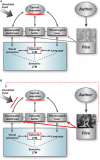The cinema-cognition dialogue: a match made in brain
- PMID: 22969715
- PMCID: PMC3432871
- DOI: 10.3389/fnhum.2012.00248
The cinema-cognition dialogue: a match made in brain
Abstract
That human evolution amalgamates biological and cultural change is taken as a given, and that the interaction of brain, body, and culture is more reciprocal then initially thought becomes apparent as the science of evolution evolves (Jablonka and Lamb, 2005). The contribution of science and technology to this evolutionary process is probably the first to come to mind. The biology of Homo sapiens permits and promotes the development of technologies and artefacts that enable us to sense and reach physical niches previously inaccessible. This extends our biological capabilities, but is also expected to create selective pressures on these capabilities. The jury is yet out on the pace at which critical biological changes take place in evolution. There is no question, however, that the kinetics of technological and cultural change is much faster, rendering the latter particularly important in the biography of the individual and the species alike. The capacity of art to enrich human capabilities is recurrently discussed by philosophers and critics (e.g., Arsitotle/Poetics, Richards, 1925; Smith and Parks, 1951; Gibbs, 1994). Yet less attention is commonly allotted to the role of the arts in the aforementioned ongoing evolutional tango. My position is that the art of cinema is particularly suited to explore the intriguing dialogue between art and the brain. Further, in the following set of brief notes, intended mainly to trigger further thinking on the subject, I posit that cinema provides an unparalleled and highly rewarding experimentation space for the mind of the individual consumer of that art. In parallel, it also provides a useful and promising device for investigating brain and cognition.
Keywords: brain; cinema; dissociative states; emotional mental travel; mental time travel; working memory.
Figures



References
-
- Andrew J. D. (1976). Major Film Theories: An Introduction. New York, NY: Oxford University Press
-
- Arima I. (2003). In Ozu (1953/2003), Disc 2. New York, NY: The Criterion Collection
-
- Aristotle. (1984). Poetics, in The Complete Works, Vol. 2, ed Barnes J. (Princeton, NJ: Princeton University Press; ), 2316–2340
-
- Baddeley A. (2007). Working Memory, Thought, and Action. Oxford: Oxford University Press; 10.1162/jocn.2010.21519 - DOI
-
- Bar M. (ed.). (2011). Predictions in the Brain. Using Our Past to Generate a Future. New York, NY: Oxford University Press
LinkOut - more resources
Full Text Sources

